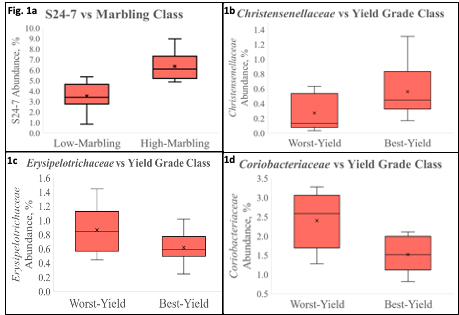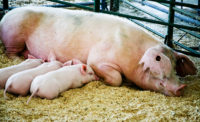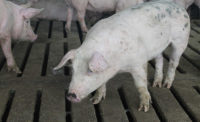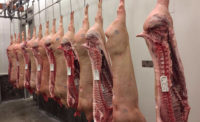Microbiome research is an area of increasing interest in livestock production due to potential microbiome impacts on animal performance. The term microbiome, while scientifically rooted in the genetic makeup of the microbes, is used to more generally represent the microbial populations that are present in an environment. Cattle, for instance, have microbial populations in their rumens that degrade the feedstuffs consumed, producing nutrients that can be absorbed and metabolized by the host for production of meat, milk, and fiber. The amounts and types of nutrients produced by the microbial populations, and thus absorbed by the host can vary, however, depending on the composition of microbes present. This variation in nutrient production and absorption likely contributes to variation in animal performance, and while most rumen microbiome research has focused on live-production traits, an area of importance that has received little investigation is the relationship between the rumen microbiome and adipose tissue development in the carcass.
Beef cattle carcass value is influenced by the quality and quantity of meat produced, both of which are related to the fat: lean ratio. The difference, however, lies mostly in the location where fat accumulates. For instance, a major determinant of a beef carcass’ USDA quality grade is the amount of intramuscular fat deposited in the longissimus muscle, such that greater amounts of intramuscular fat are associated with higher quality grades (Prime>Choice>Select>Standard). In September 2020, Prime carcasses received a $12.17/cwt premium, while Select and Standard carcasses received discounts of $12.94/cwt and $26.77/cwt, respectively. In contrast, the quantity of meat produced, as estimated by the USDA yield grade, is largely influenced by the amount of subcutaneous and intermuscular fat, with less fat in these deposits being more desirable (1>2>3>4>5). Again, in September 2020, yield grade 1-2 and 2-3 carcasses were awarded a $3.79/cwt and $1.68/cwt premium, whereas yield grade 4-5 and 5+ carcasses were discounted by $12.00/cwt and $17.57/cwt, respectively. Ultimately, these trends suggest that high yielding carcasses with higher meat quality are desired, which means our goal, in terms of adipose tissue, is to produce carcasses with increasing intramuscular fat while minimizing subcutaneous and intermuscular fat.
Due to the economic relevance of adipose tissue accumulation and the influence of the rumen microbial populations on animal performance, we asked the following question: could alterations in the rumen microbial populations impact the energy substrates available, and thus carcass composition? To answer this question, we investigated the relationships between the rumen microbial populations and adipose tissue accumulation in steers that were divergent in their quality and yield grades. We used 24 feedlot-finished Angus steers that were slaughtered at roughly 18 months of age (weight following lairage: 1197±97 lb). At slaughter we collected rumen contents from each steer, which were later processed for microbial DNA extraction and 16S rRNA gene sequencing to determine microbial relative abundances and diversity. Carcasses were chilled for 48 hours before collecting a longissimus steak sample for proximate analysis, and carcass data for the calculation of USDA yield and quality grades. For analysis, we classified the carcasses with the 10 highest and 10 lowest marbling scores into high- and low-marbling classes, respectively. Similarly, we ranked the 24 steers by their USDA yield grades and placed the 10 lowest and 10 highest yield grades into the best- and worst-yield grade classes, respectively.
| Populations | ||||
| Carcass Trait | Marbling Classes | Yield Grade Classes | ||
| High | Low | Best | Worst | |
| (n = 10) | (n = 10) | (n = 10) | (n = 10) | |
| Overall Maturity1 | A56 | A56 | A53 | A57 |
| Marbling Score2 | 760 a | 579 b | 670 | 678 |
| USDA Quality Grade3 | Prime– a | Choice° b | Choice+ | Choice+ |
| Longissimus Lipid Content, % | 10.9 a | 7.7 b | 8.8 | 10 |
| Hot Carcass Weight, lbs | 831.4 | 816.8 | 810.6 | 848.6 |
| Adjusted 12th Rib Fat Thickness, in | 0.54 | 0.51 | 0.43 a | 0.63 b |
| Ribeye Area, in2 | 12.4 | 12.4 | 13.0 a | 11.7 b |
| Kidney, Pelvic, Heart Fat, % | 2.1 | 2.2 | 2.2 | 2.3 |
| Yield Grade | 3.5 | 3.4 | 2.9 a | 4.0 b |
| Dressing Percentage, % | 61.8 | 61.7 | 61.8 | 61.8 |
| Carcass Value4 | $1,438.37 a | $1,335.69 b | $1,378.50 | $1,385.57 |
a,bDenotes carcass trait means that differed (P ≤ 0.05) between classes.
1Overall maturity was the average of bone and lean maturity
2Marbling score was converted to a numeric scale where 500=Modest00, 600=Moderate00, 700=Slightly Abundant00, and 800=Moderately Abundant00
3Choice° = USDA Average Choice, Choice+ = USDA High Choice, Prime– = USDA Low Prime
4Carcass values were calculated as an average for the month of September (2020) based on USDA Agricultural Marketing Service’s ‘National Weekly Direct Slaughter Cattle – Premiums and
Discounts’ and ‘Weekly Direct Steer and Heifer Slaughter Cattle Summary’ reports
Marbling score (Slightly Abundant70 vs Modest79) and longissimus lipid content (10.9% vs 7.7%) differed significantly between the high- and low-marbling classes which resulted in a low Prime and average Choice USDA quality grade differential, respectively (Table 1). None of the other carcass traits differed between the two marbling classes. For their rumen microbiome, 16S rRNA gene sequencing suggested that the high-marbling steers had more bacterial species present and more evenly distributed abundances (i.e., more similar in their abundances) compared to the low-marbling steers. These results suggest that the high-marbling steers had greater ruminal microbial diversity than the low-marbling steers. Additionally, bacteria in the family S24-7 were more abundant in the rumens of the high-marbling steers (6.35%) compared to the low-marbling steers (3.53%) (Fig. 1a). Previous literature has suggested that increased abundances of this bacterial family may be linked to increased propionate production. Propionate is a volatile fatty acid (VFA) that can be absorbed and metabolized by the host and has been shown to be the preferred metabolic precursor for intramuscular fat synthesis.

For the yield grade classes there were significant differences in backfat thickness (0.43 vs 0.63 in.) and ribeye area (13.0 vs 11.7 in2), which resulted in significantly different USDA yield grades (2.9 vs 4.0) for the best- and worst-yield grade classes, respectively (Table 1). Aside from these yield traits, no other carcass traits differed between the two classes. There was a tendency for the best-yield grade steers to have microbial specie abundances that were more evenly distributed (i.e., more similar abundances) compared to the worst-yield grade steers. The bacterial family Christensenellaceae was more abundant in the rumens of the best-yield grade steers (0.56%) compared to the worst-yield grade steers (0.27%) (Fig. 1b). These results are consistent with Christensenellaceae’s reoccurring link to human health, such that abundances of this family are often higher in people with a normal body mass index (BMI) (similar to our leaner, better yielding carcasses), whereas lower abundances are found in people with an obese BMI (similar to our fatter, lower yielding carcasses). The bacterial families Erysipelotrichaceae (0.62% vs. 0.87%) and Coriobacteriaceae (1.52% vs 2.40%) had similar trends in the rumen with lower abundances of these families being found in the best- compared to the worst-yield grade steers, respectively (Fig. 1c and 1d).
Profitability in the beef industry is heavily influenced by the quality and quantity of beef produced from a given carcass. Using the premiums and discounts mentioned above, the steers in the low-marbling class had an average carcass value of $1,335.69 compared to $1,438.37 for the high-marbling class, which equates to over a $100/head increase in value for improved carcass quality. Thus, every opportunity to improve both the quality and yield grades of beef carcasses at the producer level should be fully explored. Moreover, our results suggest that differences in ruminal microbial abundances and diversity are linked to differing performance in carcass adipose traits. Further investigation is needed, however, to explore the individual nutrient contributions of the microbial populations and how those nutrients impact lipid synthesis (intramuscular vs. subcutaneous fat) in the host. Ultimately, the goal is to better understand the microbes’ role in adipose tissue accumulation in anticipation of utilizing the microbiome as a means of improving beef quality and yield grades, and in the end profitability for the industry.




Report Abusive Comment